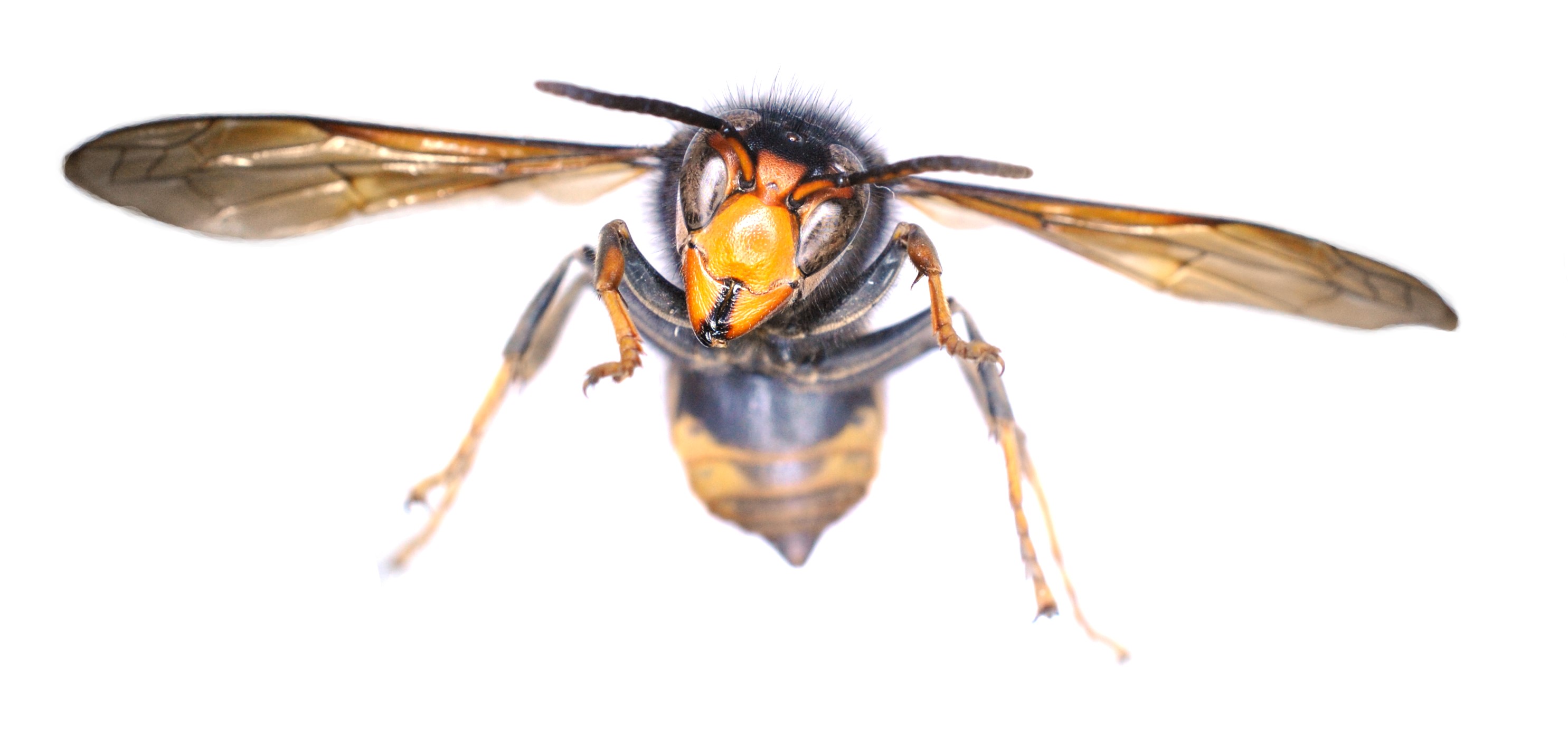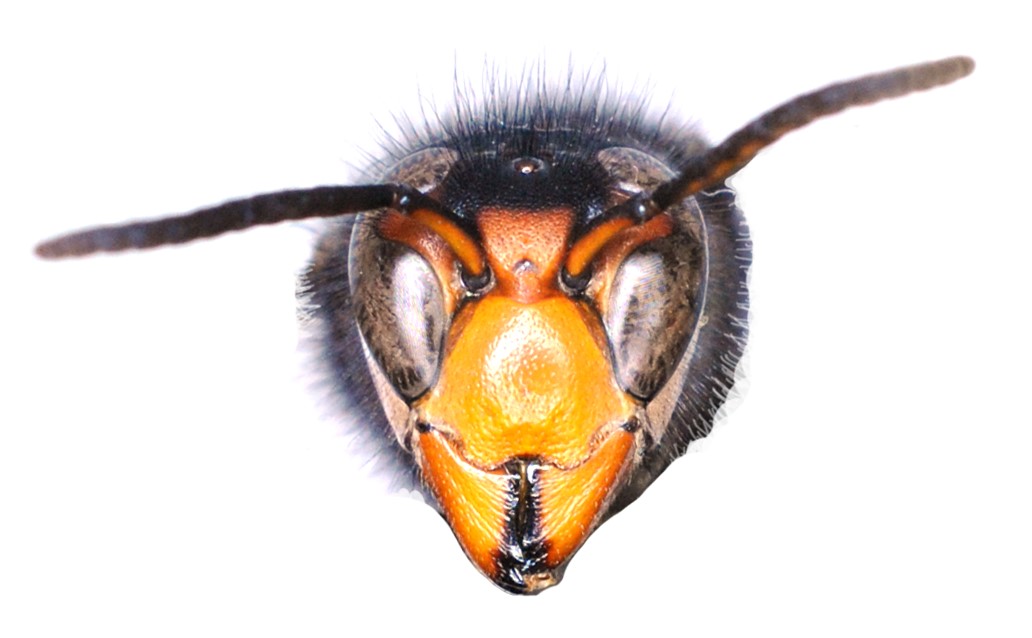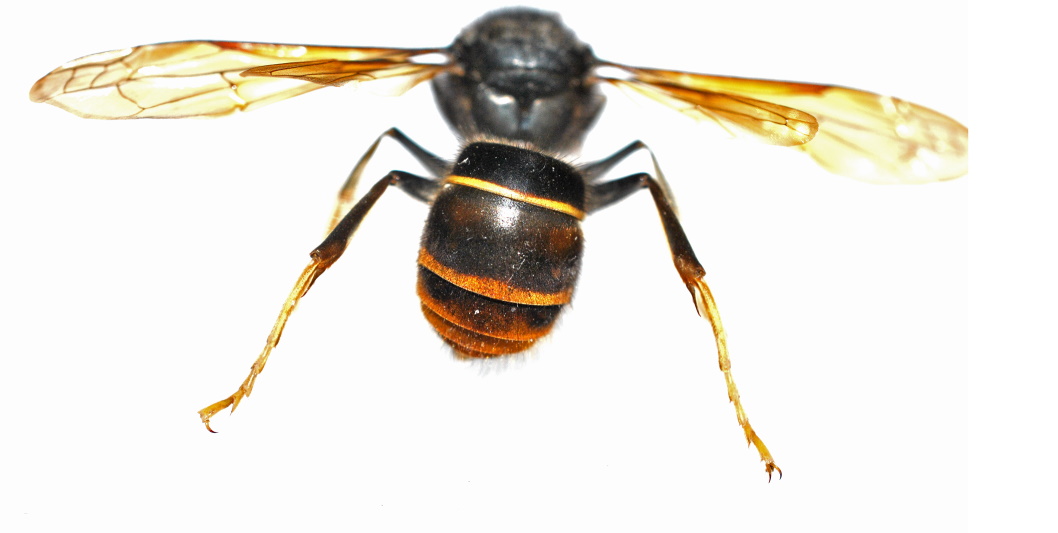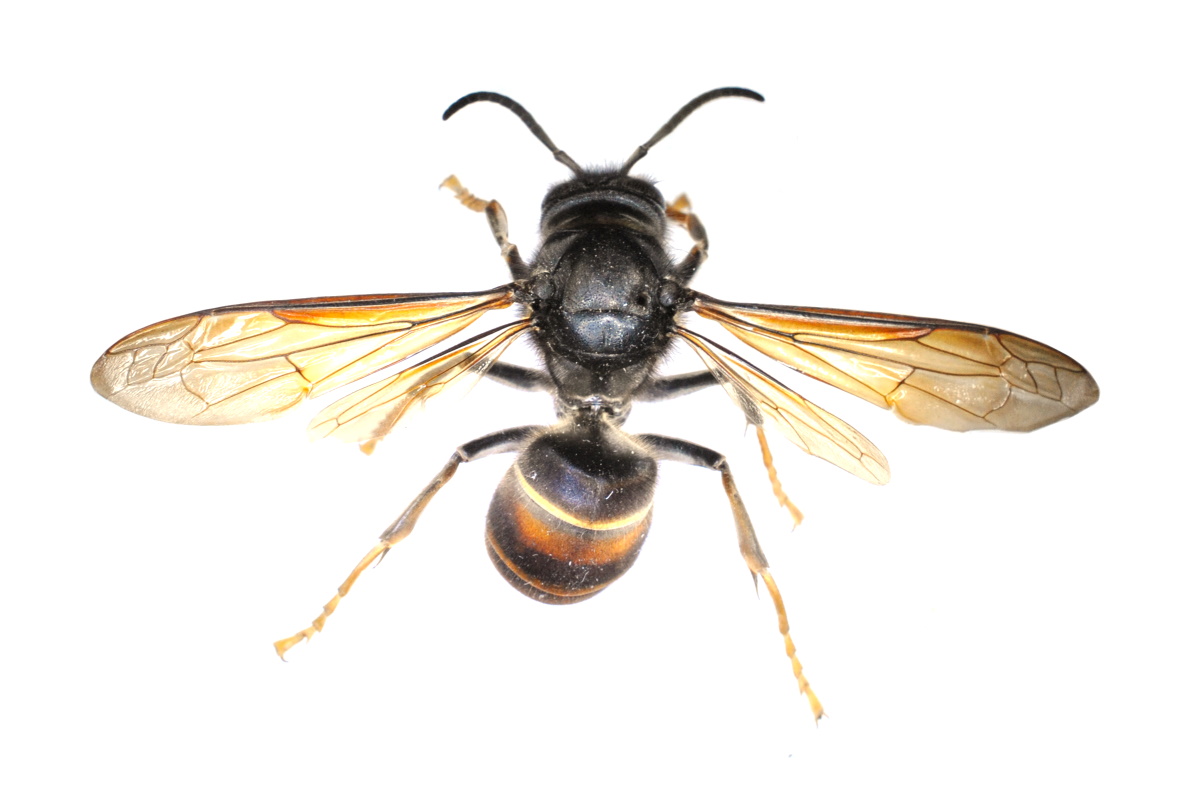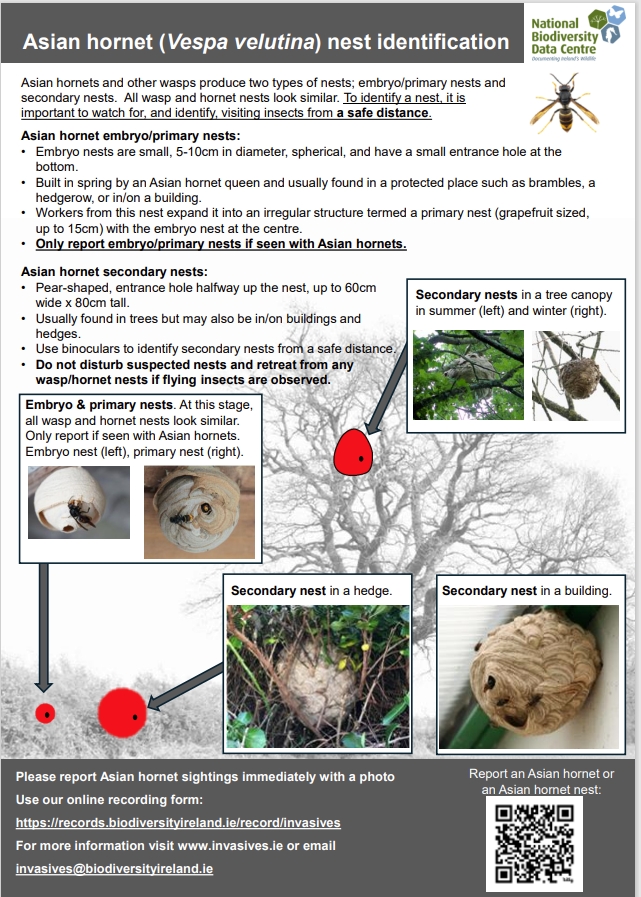Species Alert Issued by: the the National Biodiversity Data Centre on behalf of the National Parks and Wildlife Service (NPWS).
- Press release issued 13th August 2025. Press release issued 28th August 2025; and
- Press release issued 7th May 2021.
Introduction status: Not known to be established. One individual was found ‘alive but dying’ on 25th of April 2021; one nest removed from Cork City and another from Cobh in September 2025.
Reason for issue of Species Alert: to notify of the first verified sighting in Ireland of a single specimen of Asian hornet in 2021, a regulated Invasive Alien Species of Union concern. Species Alert updated 10th September 2025.
Is there a reference specimen?: Yes. The 2021 Asian hornet specimen was verified by Dr. A. O’Hanlon of the National Museum of Ireland as a female Asian hornet (Vespa velutina) colour form nigrithorax. The specimen is retained in the museum collections. Asian hornet specimens and the two nests removed in 2025 are deposited with the National Museum of Ireland.
Known distribution of Asian hornet in Ireland: A single hornet was discovered in a home garage on the northside of Dublin in 2021. Asian hornets and two nests were recorded and removed from Co. Cork in 2025. A single Asian hornet was recorded in Dublin in July 2025. A rolling up-date on Asian hornet verified records in 2025 is available from: Asian hornet rolling update – 2025 – Invasives.ie.
Pathway of introduction:
The circumstances of how the 2021 and 2025 hornets arrived in the country are not known. There are many possible pathways of introduction particularly to urban areas near hubs and entry points with extensive regional, national and international connectivity.
Response actions taken to the 2025 verified sighting:
- Species identity verified by entomologists with National Parks and Wildlife Service and the National Museum of Ireland.
- The Asian Hornet Management Group (AHMG) is established. The group is chaired by the NPWS includes the Department of Agriculture Food and the Marine, the National Biodiversity Data Centre and the National Museum of Ireland and will co-ordinate efforts, gather further information and monitor the situation over the coming weeks.
- A survey team was quickly deployed and extensive monitoring and surveying conducted. Monitoring traps are deployed in the vicinity of the sighting.
- The survey team has engaged extensively with businesses, local communities and stakeholders in the area to raise awareness on how to identify Asian Hornet. Beekeeping associations have been briefed and are playing their part.
- Subsequent surveillance led to discovery of an Asian hornet in one of the monitoring traps on 12th August 2025.
- Press release issued 13th August 2025 by the National Parks and Wildlife Service of the Department of Housing.
- Tracking of Asian hornets led to discovery of an Asian hornet secondary nest on 27th August 2025. Department of Housing issue press release on 28th August. See RTE News clip (28/08/2025) with Ainle NiBhriain of NPWS: Video | Asian hornet nest located in Cork city following hunt | RTÉ
- Asian hornet nest in Cork City removed 5th September 2025. Asian hornet nest in Cobh removed 9th September 2025.
- Rolling up-date on Asian hornet sightings and nest destruction for 2025: https://invasives.ie/asian-hornet-rolling-update-2025
Response actions taken to the 2021 verified sighting:
- Specimen collected by the National Museum of Ireland and verified as Vespa velutina.
- National Parks and Wildlife Service and the Department of Agriculture Food and Marine (DAFM) committed to immediate additional surveillance for the Asian Hornet, especially around entry points in Ireland with direct access to mainland Europe including ports and airports along with large distribution hubs.
- Other surveillance traps will be set in strategic locations from the original point of detection in Dublin 3. This is in addition to the sentinel apiary programme that DAFM operate with the cooperation of volunteer beekeepers. This involves surveillance for Asian Hornet at apiaries located at strategic locations around Ireland.
- Formal notification to the European Commission of the detection of Asian hornet in Ireland issued 7th of May 2021 under the EU Regulation on Invasive Alien Species (1143/2014) and again on 13th August 2025.
- Press release issued 7th of May 2021 by the National Parks and Wildlife Service of the Department of Housing.
- Species alert issued 7th of May 2021 on the National Biodiversity Data Centre website and social media accounts.
- National Biodiversity Data Centre maintains an online reporting function: https://records.biodiversityireland.ie/record/invasives
- Detailed assessment of the risk of Asian hornet to Ireland was undertaken in July 2023. It concluded the overall risk of Asian hornet to Ireland as LOW with a medium level of confidence. See: https://invasives.ie/app/uploads/2021/05/Irish-V.-velutrina_RiskAssessment_July2023_V1.pdf. It is important to note that if/as the status of Asian hornet occurrences in Great Britain changes, then that information will need to be considered in further version of the Asian hornet risk assessment.
With thanks to the recorders for notifying the National Biodiversity Data Centre of their sightings with photos.
Summary of potential impacts:
The Asian hornet is a predator of honeybees, wasps, other pollinators such as bumblebees, hoverflies and spiders, which it uses primarily to feed its larvae. These prey are important for pollination of crops as well as wild flora and disruptions to their populations may have serious impacts on biodiversity and pollination services. Honeybees are its main prey with potential consequences for the honey production sector. However, the potential of the Hornet to become invasive in Ireland is dependent on its successful establishment of colonies here.
Asian hornet will also sting people but in general, the sting is no worse than a sting from any bee or wasp in Ireland. The reaction experienced by people from their sting varies – as it does with wasp or bee stings – from most commonly a mild localized hive like throbbing swelling to more rarely, a severe reaction of anaphylaxis.

Identification features: Large hornet with a generally dark appearance with an orange face. Mistaken identity in Ireland with native species has occurred however, the following characteristics can help with identification:
- Queen up to 3 centimetres & worker up to 2.5 centimetres long
- Dark colour antennae
- Long orange face
- Entirely brown or black thorax so no stripes on the middle/thorax section.
- Abdomen mostly black except for yellow band across the 4th segment with orangey-coloured lower segments.
- Legs yellow at the ends
- It has a small thin stinger that is retractable so normally not visible.
Please click on this Asian hornet comparison identification guide to aid with identification. Guide to identifying nests is also available here.
What should I do and who to contact?
- Become familiar with the identification features of Asian hornet
- Report suspected sightings in Ireland with a photograph through this online form https://records.biodiversityireland.ie/record/invasives or the Biodiversity Data capture app.
- Report suspected sightings in Northern Ireland via: The Asian Hornet Watch app; the CEDaR online recording form; at iRecord or call the Non-Native Invasive Species Team at the Northern Ireland Environment Agency – Tel: 028 9056 9558
- If you have an apiary and and want to report a suspected Asian hornet or have concerns for bee health, contact the Horticulture and Plant Health Unit of DAFM. E-mail: [email protected]
- If you are travelling to countries with established populations of Asian hornet please be mindful to check your belongings and vehicles before returning for any possible ‘hitchhiker’ species. In Europe, Asian hornet is present in many countries including France, Germany, Italy, Portugal, Spain and some of the Channel islands and is spreading rapidly. See the DAFM Don’t Risk it Campaign.
- It is important that there should not be an over-reaction to sightings of other large insects such as wood wasps and native social wasps. It is imperative other species are not targeted, disrupted or destroyed on foot of this discovery of one Asian hornet individual.
Additional Resources:
- Irish Bee Keepers Association webpage on Asian hornet with links to very useful additional information: www.irishbeekeepers.ie/beekeeping/asian-hornet/
- Department of Agriculture, Food and Marine (DAFM) Asian hornet Information sheet
- Referenced species account for Asian hornet: https://species.biodiversityireland.ie/profile.php?taxonId=187087&taxonName=vespa%20velutina
- Asian hornet New Fact sheet posters 2.9.21 and Life History infographic produced by the Atlantic+ve project
- Invasive Species Ireland Asian hornet species account and further resources: http://invasivespeciesireland.com/species-accounts/potential/terrestrial/asian-hornet
- Up-dates on Asian hornet news from the UK can be accessed from: www.gov.uk/government/publications/asian-hornet-uk-sightings
- Dillane E, Hayden R, O’Hanlon A, Butler F, Harrison S (2022) The first recorded occurrence of the Asian hornet (Vespa velutina) in Ireland, genetic evidence for a continued single invasion across Europe. Journal of Hymenoptera Research 93: 131–138. https://doi.org/10.3897/jhr.93.91209
- Detailed assessment of the risk of Asian hornet to Ireland (July 2023). It concluded the overall risk of Asian hornet to Ireland as LOW with a medium level of confidence. See: https://invasives.ie/app/uploads/2021/05/Irish-V.-velutrina_RiskAssessment_July2023_V1.pdf. It is important to note that if/as the status of Asian hornet occurrences in Great Britain changes, then that information will need to be considered in further version of the Asian hornet risk assessment.


